Climate Modelling and Prediction
Computational models of climate help understand the mechanisms at work and enable predictions. Our initial focus was on high resolution local area models that capture salient features of Sri Lanka’s climate. We developed a simple model for capturing the topographically induced rainfall. Separately, we developed a high-resolution wind climate model while ignoring the rainfall mechanisms. Thereafter we also partnered with Joshua Qian at the IRI in his work on a Regional Climate Model for Sri Lanka.
We have investigated the skill of predictions over Sri Lanka by the IRI’s seasonal forecast system. We collaborated to implement a statistical methodology to correct the predictions of global models of rainfall over Sri Lanka at high resolution.
| Activity |
Objectives
|
Partners | Status | Next Steps |
| Mesoscale Wind Modelling |
Generate 2-D wind climatologies |
Iowa State University |
Investigate causes of model error in some months. Draft papers available. |
Develop 2-D wind resource assessment. Refine papers for publications. |
| Orographic Rainfall Modelling |
Extend 2-D orographic rainfall model to generate slices of prediction. |
IRI |
Obtain upper air data sets for work, obtain East-West slices of Sri Lankan topography. |
Paper on orographic rainfall over Sri Lanka. Assess effects of pollution on orographic rainfall. |
| Regional Climate Modelling focused on Sri Lanka |
Develop new methodologies for high-resolution climate prediction |
IRI (Joshua Qian), Int. Center for Theoretical Physics, Met. Dept. |
High Resolution climate model developed for Sri Lanka and shown to be essential for capturing regional
variations. |
Further development of nesting algorithms, model runs for extra years, implementation of model in Sri Lanka
publications. |
| Statistical Down-scaling |
Generate statistical predictions for all seasons for Sri Lanka |
IRI | October to December season predictions completed. Paper drafted. |
Develop predictions for all seasons. Publish OND paper. |
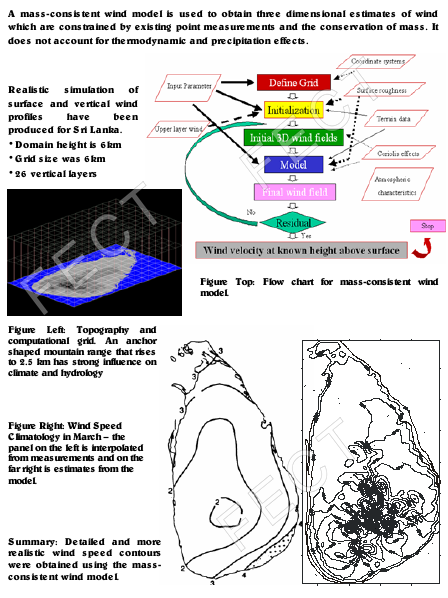
Orographic Rainfall Modeling
Orographic rainfall is brought about by the uplift of moist air by mountains leading to
precipitation. Orographic rainfall modelling is useful because, it is a means of understanding the physical
mechanisms of precipitation; it provides a basis for interpolating and extrapolating rainfall observations; and it
provides a simple downscaling mechanism between large scale atmospheric features such as circulation and moisture
budgets and local rainfall. These large scale features may be obtained from radiosonde measurements, reanalyses data
or GCM’s.
Orographic rainfall is particularly important for water resource studies in tropical regions as
many rivers obtain a large part of their rainfall in the mountain regions. Sri Lanka is under the semi-annual
monsoonal changes in wind directions. The mean wind direction from May to October is from the West and from December
to March is from the North-East. The strongest westerly winds are in July and the strongest North-Easterly winds are
during January. While the wind intensity in January is half of that during July, it is still critical in inducing
rainfall in an otherwise dry part of Sri Lanka. Since orographic rainfall is caused by such intense lateral winds,
we present an analysis of rainfall for July.
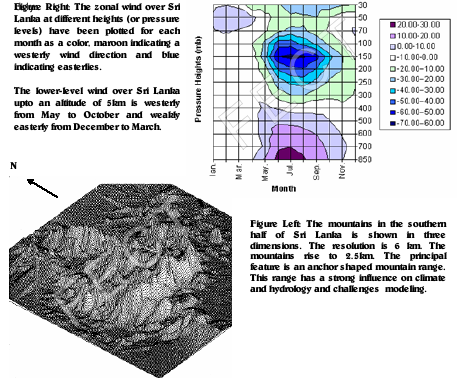
Orographic Rainfall Model for July
To model mountain induced rainfall, we first computed the vertical velocity across a mountain West-East
cross-section; then estimated the moisture across the section and then established the extent of condensation and
precipitation. Based on assumptions of distribution of rain droplets, we estimate where the rain shall fall.
This model may be tested against average rainfall along stations close to the cross-section when the
westerlies are strongest. We have obtained the average monthly July rainfall for stations in the East-West
cross-section going from Colombo to Pottuvil. The actual rainfall values and the model predictions are shown below.
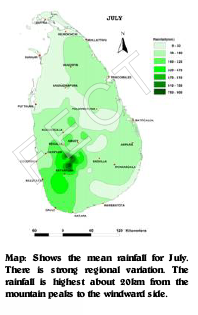 |
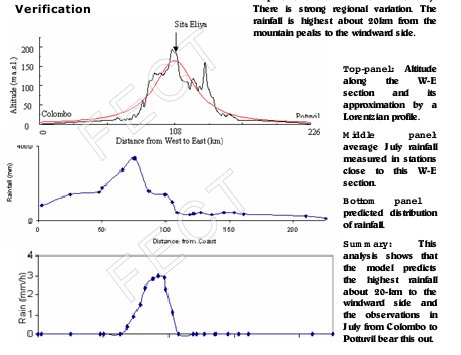 |


Regional Climate Modelling
Sri Lanka climate is downscaled from a global atmospheric general circulation model ECHAM4.5 using a regional climate model RegCM3.
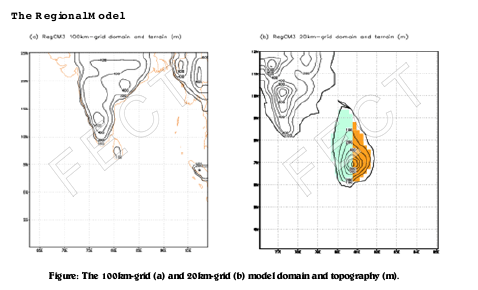
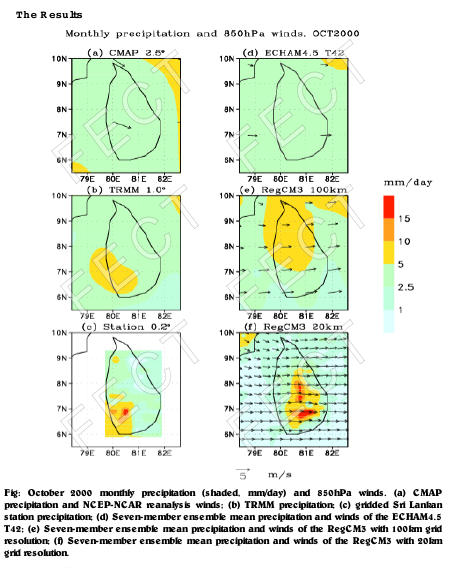
Seasonal Climate Predictions - IRI
These forecasts are based on global climate simulations by four Global Climate Models which are initialized based on observations of global ocean surface temperatures. These simulations are at a resolution of approximately 250 km. And thus Sri Lanka is captured in two grid boxes.
Seasonal climate forecasting is a new field and the skill obtained thus far is good for regions such as Indonesia, North-East Brazil, and East Africa. In general, the forecast skill for Asia and Europe is weaker than that for other continents. The regions with the most skill within Asia are South-East Asia and South Asia. However, the skill is likely to improve in the coming years.
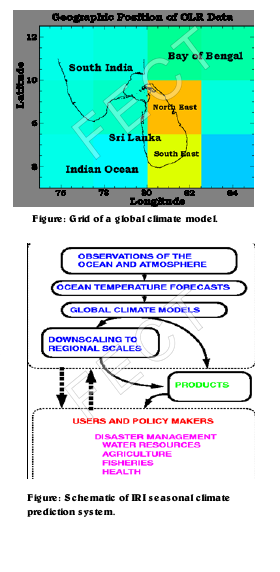
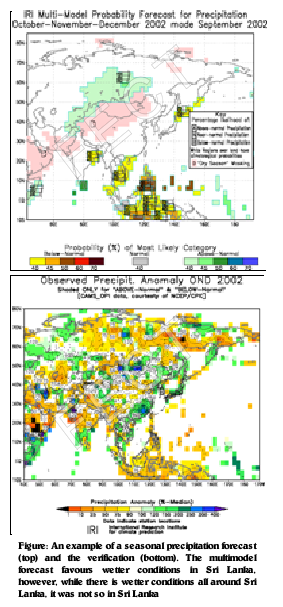
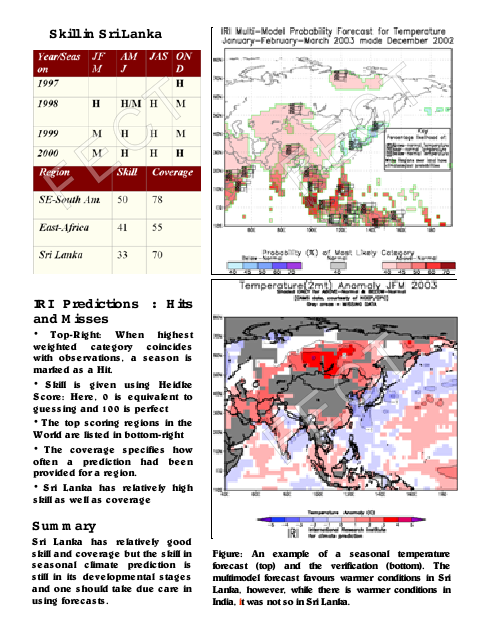
Statistical Downscaling of Predictions
The large-scale atmospheric circulation across the Indian Ocean sector has a strong degree of
predictability in the October-December season. This provides a basis for investigating predictability at spatial
scale. We ask the question: for a given large-scale wind forecast across the region, what are the details of the
rainfall pattern to expect across Sri Lanka? Two ways to answer this question are
Run a high resolution
climate model driven with the large-scale wind fields from the Global Climate Model
Establish the
statistical relationship between the details of the observed rainfall pattern and the large-scale wind forecast
– using analysis over a large set of past years – and use these relationships to forecast each location,
given a large-scale wind forecast.
Using the statistical approach, we find that there is good skill on the
eastern side. This skill is physically based – since wetter years appear to be associated with SST that
enhances the easterly surface wind component across the region – which will impinge on the eastern side of the
island first and give rise to particularly enhanced precipitation on eastward facing slopes.
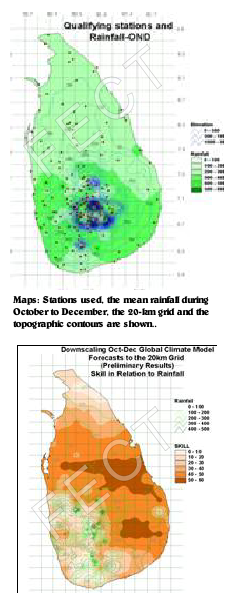
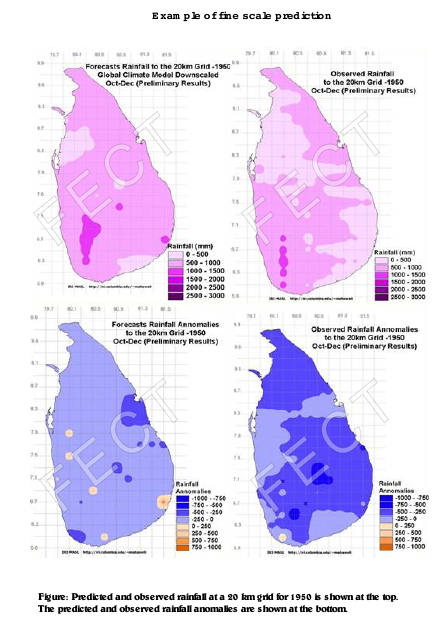
Conference proceedings
- Dec 2004: Lareef Zubair, Joshua Qian, Neil Ward, Ousmane Ndiaye, Janaki Chandimala, Ruvini Perera, Vidhura Ralapanawe and Benno Blumenthal, Complementary Dynamical and Statistical Downscaling from a GCM: Maha rainfall over Sri Lanka, Annual Meeting of the American Geophysical Union, San Francisco.
- Nov 2004: Downscaling of Sri Lanka's Maha Rainfall from a GCM and Indian Ocean Dipole and ENSO influences, International Conference on Sustainable Water Resources Management in the Changing Environment of the Monsoon Region, United Nations University, Colombo, Sri Lanka.
- May 2004: Joshua Qian and Lareef Zubair, High-resolution dynamic regional climate downscaling over Sri Lanka, 10th Asian Congress of Fluid Mechanics, Peradeniya, Sri Lanka.
- May 2004: Lareef Zubair and Ajith Gunaratne, Wind Climatologies From A Mass-Consistent Wind Model For Sri Lanka, 10th Asian Congress of Fluid Mechanics, Peradeniya, Sri Lanka.
- Oct 2000: A dynamical model for orographic rainfall in monsoonal Sri Lanka, National Oceanic and Atmospheric Agency 25th Climate Diagnostics Workshop, New York 25:305-308.
- Dec 1999: A dynamical model for orographic rainfall in Sri Lanka, Proceedings of the 8th Asian Fluid Dynamics Congress, Shenzen, China 8:864-867.
Reports
- February 2001: Lareef Zubair, Skill Assessment of IRI predictions over South Asia, IRI internal report.